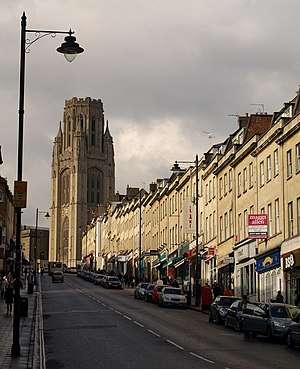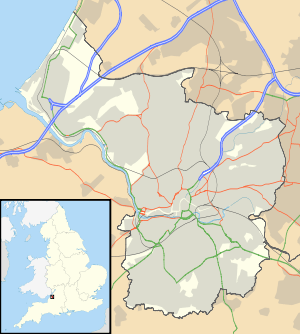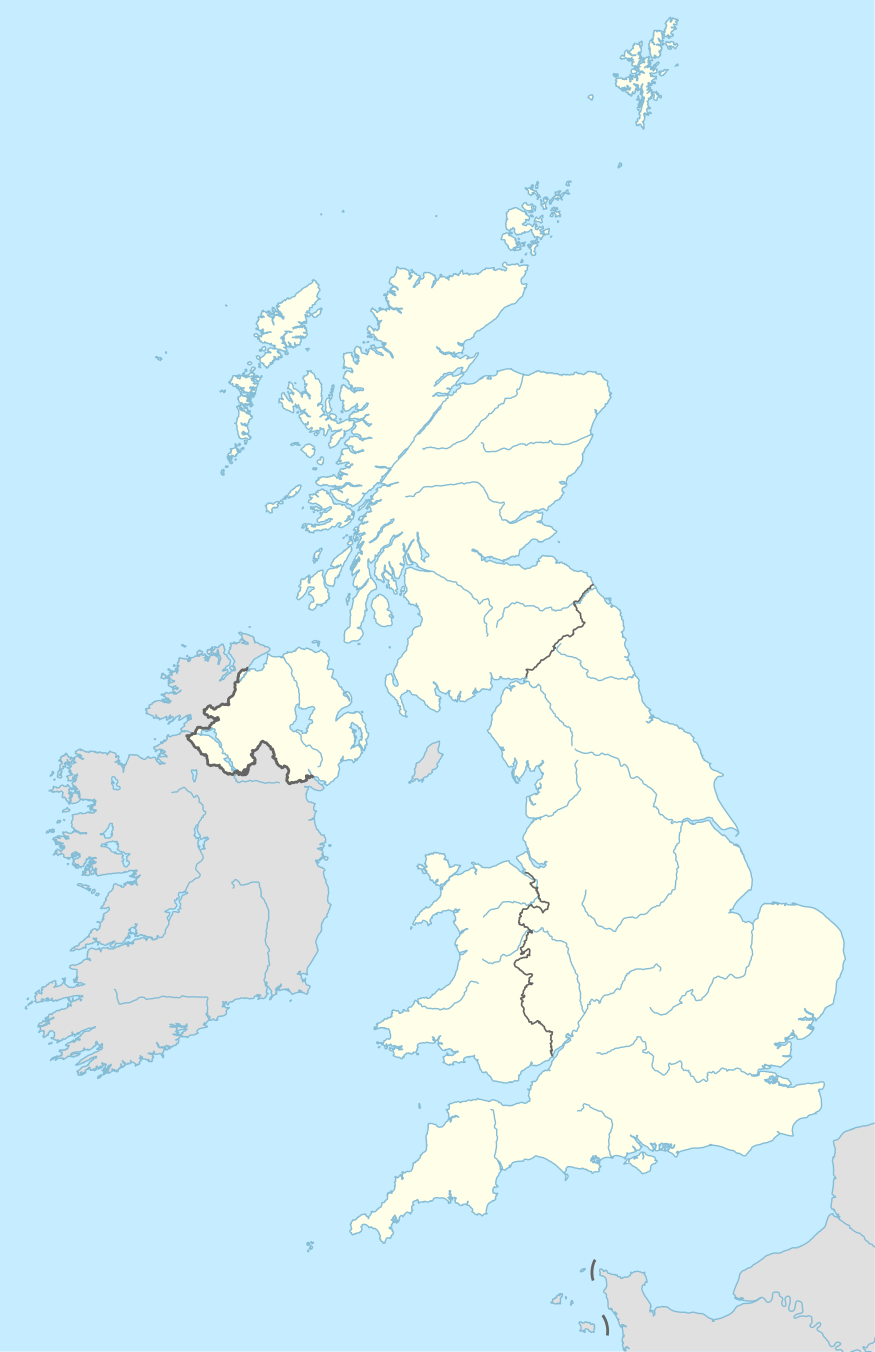Park Street riot
The Park Street riot occurred in Park Street and George Street Bristol, England, on 15 July 1944 when many black US servicemen (GIs) refused to return to their camps after US military policemen (MPs) arrived to end a minor fracas. More MPs were sent, up to 120 in total, and Park Street was closed with buses. In subsequent confrontations an MP was stabbed, a black GI was shot dead, and several others were wounded.[1]
| Park Street riot | |||
|---|---|---|---|
 Park street, where the riot started | |||
| Date | 15 July 1944 | ||
| Location | Park Street, Bristol, United Kingdom 51.456868°N 2.605766°W | ||
| Caused by | Racial tensions | ||
| Parties to the civil conflict | |||
| |||
| Casualties | |||
| Death(s) | 1 | ||
| Injuries | Several | ||
 Location of park Street  Park Street riot (the United Kingdom) | |||
Background
During World War II, African-Americans formed 10 per cent of US Army servicemen in Britain, a total of about 150,000 in 1944.[1][2] Most were in labour companies, engineers, stevedores and transport units. Many were based in the Bristol area because of the docks there. They had their barracks in Bedminster, Brislington, Henleaze, Shirehampton and the Muller Orphanage at Ashley Down.[1]
The US Armed Forces were still racially segregated, and the soldiers of the labour companies were almost entirely black, while most of their officers were white, as were the MPs. Military commanders tended to treat these service units as "dumping grounds" for less competent officers, and leadership in the labour companies was poor.[3]
The British government did not approve of segregation but decided they could not interfere in the treatment of African-American people enlisted in the US army.[1] The British authorities would not organise segregated facilities nor enforce segregation in non-US Army facilities. In response the US Army administration encouraged separate days along the week for black and white troops to have leave passes.[1] The US military actively developed a policy that involved the segregation of many facilities in Britain.[1] Two separate Red Cross centres existed in Bristol: St George Street for coloured GIs; and Berkeley Square for whites.[1]
Earlier incidents
There were frequent clashes between black and white GIs.
Fist fights almost always broke out when black and white GIs were drinking in the same pub. There were some shootings, most by whites against blacks. (Major General Ira Eaker, commander of the Eighth Air Force, declared that white troops were responsible for 90 per cent of the trouble), and a few killings—all covered up by the army.[4]
A US survey of soldiers' mail during the war revealed that white troops were particularly indignant about the public association of white women with black soldiers, which was unremarkable in Britain.[5]
In June 1943 a significant racial incident, the Battle of Bamber Bridge, led to one death, 7 wounded and 32 court martialled; this followed the riots in Detroit earlier that week.[6] In September 1943 at Launceston in Cornwall there was another armed confrontation between black GIs and MPs which left two MPs wounded; 14 black GIs were court martialled.[1]
The days before the Park Street Riot saw an increase in tension between the black and white GIs. On 10 July at the Muller Orphanage, where some of the black troops were billeted, several white paratroopers arrived.[7] The black soldiers claimed that they were insulted and then beaten by the paratroopers.[7]
545th Port Company mutiny
On the night of 12–13 July the 545th Port Company, an all-black segregated unit that was billeted at Sea Mills, mutinied. On the morning of 13 July the company refused direct orders to report for duty and remained in the barracks.[7] They demanded better treatment from their officers, better accommodation for the soldiers in the guardhouse, and a halt to the paratroopers chasing black GIs through the streets of Bristol.[8] The mutiny ended the same evening, without violence.[8] One black soldier, Robert Davis of 542nd Port Company was accused of inciting the mutiny, and was court martialled on 6 September 1944 in Newport. He was sentenced to hard labour for life.[8]
Riot
On the evening of Saturday 15 July approximately 400 black GIs gathered in the area of Park Street.[7] Some of them were accompanied by white British women and a US military policeman stopped them.[9] This caused a minor disturbance which prompted the deployment of more policemen. In total 120 armed military policemen attended.[1] The black soldiers were gathered to march back to the trucks that were to drive them to their barracks. The MPs tried to disarm some of them who had knives. The black soldiers refused to hand them over, their colleagues intervened and in the resulting confrontation one policeman was stabbed and his attacker shot dead. The MPs restored control by closing off the street with buses and shooting several GIs in the legs.[7] Many black GIs were arrested and several were sent to the local hospital. A curfew was established in Bristol for many days afterwards.[7]
See also
References
- Wynn, Neil A. (November 2006). "'Race War': Black American GIs and West Indians in Britain During The Second World War". Immigrants & Minorities: Historical Studies in Ethnicity, Migration and Diaspora. 24 (3): 324–346. doi:10.1080/02619280701337146. ISSN 0261-9288.
- Ambrose, Stephen E. (1997). D-Day. London: Pocket Books. p. 147. ISBN 978-0-7434-4974-8.
- Nalty, Bernard C. (1 January 1986). Strength for the Fight: A History of Black Americans in the Military. Simon and Schuster, Free Press. pp. 154–157, 228. ISBN 9780029224113.
- Ambrose, Stephen E. (1997). D-Day. London: Pocket Books. p. 148. ISBN 978-0-7434-4974-8.
- Ambrose, Stephen E. (1997). D-Day. London: Pocket Books. p. 148. ISBN 978-0-7434-4974-8.
- "When the American military said sorry to Bamber Bridge". Lancashire Evening Post. 12 April 2012. Retrieved 2 June 2017.
- brisray@yahoo.co.uk, Ray Thomas -. "Riots (2)". brisray.com. Retrieved 12 February 2018.
- Judge Advocate General's Department (1946). Board of Review (PDF). 11. Washington: Office of Judge Advocate General. pp. 81–90.
- "City Inquiry into main street shooting match between rioting troops". Daily Mirror. 19 July 1944. Retrieved 19 February 2018.
External links
- "Bristol's little-known role in US civil rights movement". BBC News. Retrieved 16 February 2018.